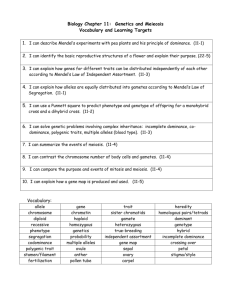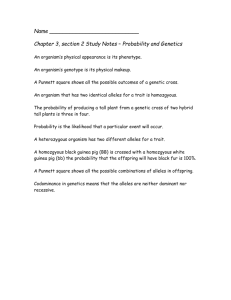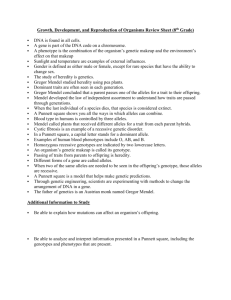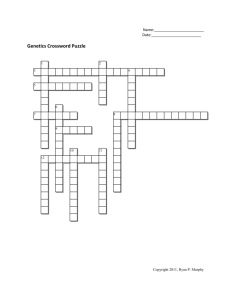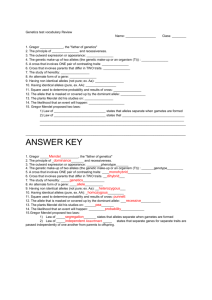True-breeding/ genetics/ hybrids/ genes/ alleles/ segregation
advertisement
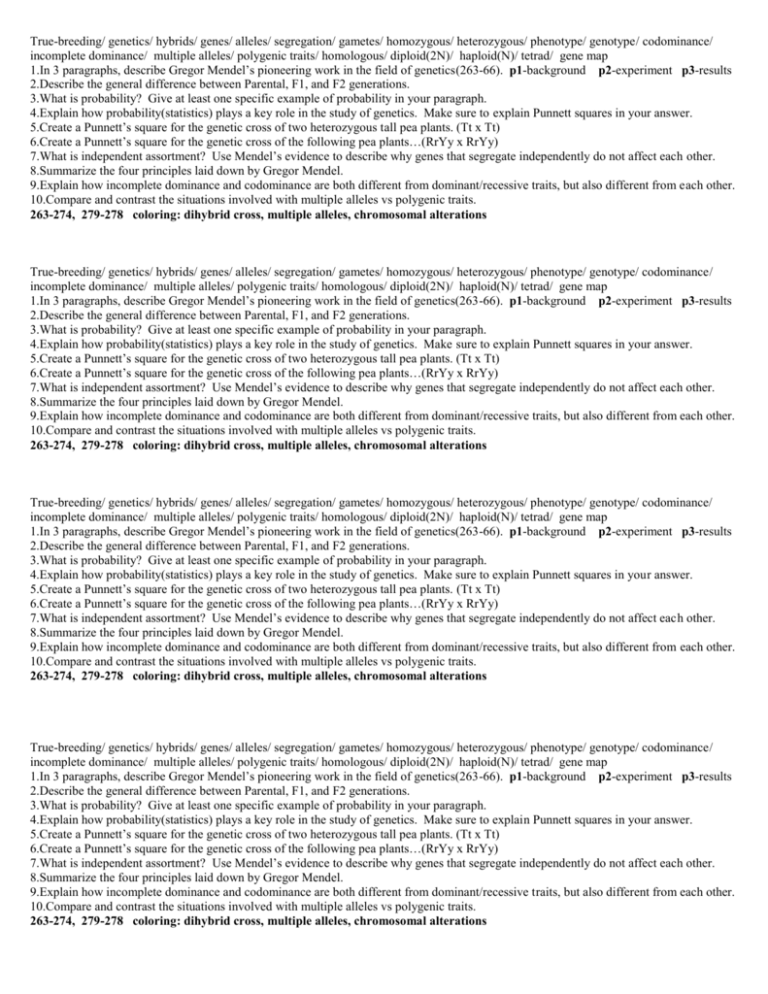
True-breeding/ genetics/ hybrids/ genes/ alleles/ segregation/ gametes/ homozygous/ heterozygous/ phenotype/ genotype/ codominance/ incomplete dominance/ multiple alleles/ polygenic traits/ homologous/ diploid(2N)/ haploid(N)/ tetrad/ gene map 1.In 3 paragraphs, describe Gregor Mendel’s pioneering work in the field of genetics(263-66). p1-background p2-experiment p3-results 2.Describe the general difference between Parental, F1, and F2 generations. 3.What is probability? Give at least one specific example of probability in your paragraph. 4.Explain how probability(statistics) plays a key role in the study of genetics. Make sure to explain Punnett squares in your answer. 5.Create a Punnett’s square for the genetic cross of two heterozygous tall pea plants. (Tt x Tt) 6.Create a Punnett’s square for the genetic cross of the following pea plants…(RrYy x RrYy) 7.What is independent assortment? Use Mendel’s evidence to describe why genes that segregate independently do not affect each other. 8.Summarize the four principles laid down by Gregor Mendel. 9.Explain how incomplete dominance and codominance are both different from dominant/recessive traits, but also different from each other. 10.Compare and contrast the situations involved with multiple alleles vs polygenic traits. 263-274, 279-278 coloring: dihybrid cross, multiple alleles, chromosomal alterations True-breeding/ genetics/ hybrids/ genes/ alleles/ segregation/ gametes/ homozygous/ heterozygous/ phenotype/ genotype/ codominance/ incomplete dominance/ multiple alleles/ polygenic traits/ homologous/ diploid(2N)/ haploid(N)/ tetrad/ gene map 1.In 3 paragraphs, describe Gregor Mendel’s pioneering work in the field of genetics(263-66). p1-background p2-experiment p3-results 2.Describe the general difference between Parental, F1, and F2 generations. 3.What is probability? Give at least one specific example of probability in your paragraph. 4.Explain how probability(statistics) plays a key role in the study of genetics. Make sure to explain Punnett squares in your answer. 5.Create a Punnett’s square for the genetic cross of two heterozygous tall pea plants. (Tt x Tt) 6.Create a Punnett’s square for the genetic cross of the following pea plants…(RrYy x RrYy) 7.What is independent assortment? Use Mendel’s evidence to describe why genes that segregate independently do not affect each other. 8.Summarize the four principles laid down by Gregor Mendel. 9.Explain how incomplete dominance and codominance are both different from dominant/recessive traits, but also different from each other. 10.Compare and contrast the situations involved with multiple alleles vs polygenic traits. 263-274, 279-278 coloring: dihybrid cross, multiple alleles, chromosomal alterations True-breeding/ genetics/ hybrids/ genes/ alleles/ segregation/ gametes/ homozygous/ heterozygous/ phenotype/ genotype/ codominance/ incomplete dominance/ multiple alleles/ polygenic traits/ homologous/ diploid(2N)/ haploid(N)/ tetrad/ gene map 1.In 3 paragraphs, describe Gregor Mendel’s pioneering work in the field of genetics(263-66). p1-background p2-experiment p3-results 2.Describe the general difference between Parental, F1, and F2 generations. 3.What is probability? Give at least one specific example of probability in your paragraph. 4.Explain how probability(statistics) plays a key role in the study of genetics. Make sure to explain Punnett squares in your answer. 5.Create a Punnett’s square for the genetic cross of two heterozygous tall pea plants. (Tt x Tt) 6.Create a Punnett’s square for the genetic cross of the following pea plants…(RrYy x RrYy) 7.What is independent assortment? Use Mendel’s evidence to describe why genes that segregate independently do not affect each other. 8.Summarize the four principles laid down by Gregor Mendel. 9.Explain how incomplete dominance and codominance are both different from dominant/recessive traits, but also different from each other. 10.Compare and contrast the situations involved with multiple alleles vs polygenic traits. 263-274, 279-278 coloring: dihybrid cross, multiple alleles, chromosomal alterations True-breeding/ genetics/ hybrids/ genes/ alleles/ segregation/ gametes/ homozygous/ heterozygous/ phenotype/ genotype/ codominance/ incomplete dominance/ multiple alleles/ polygenic traits/ homologous/ diploid(2N)/ haploid(N)/ tetrad/ gene map 1.In 3 paragraphs, describe Gregor Mendel’s pioneering work in the field of genetics(263-66). p1-background p2-experiment p3-results 2.Describe the general difference between Parental, F1, and F2 generations. 3.What is probability? Give at least one specific example of probability in your paragraph. 4.Explain how probability(statistics) plays a key role in the study of genetics. Make sure to explain Punnett squares in your answer. 5.Create a Punnett’s square for the genetic cross of two heterozygous tall pea plants. (Tt x Tt) 6.Create a Punnett’s square for the genetic cross of the following pea plants…(RrYy x RrYy) 7.What is independent assortment? Use Mendel’s evidence to describe why genes that segregate independently do not affect each other. 8.Summarize the four principles laid down by Gregor Mendel. 9.Explain how incomplete dominance and codominance are both different from dominant/recessive traits, but also different from each other. 10.Compare and contrast the situations involved with multiple alleles vs polygenic traits. 263-274, 279-278 coloring: dihybrid cross, multiple alleles, chromosomal alterations
